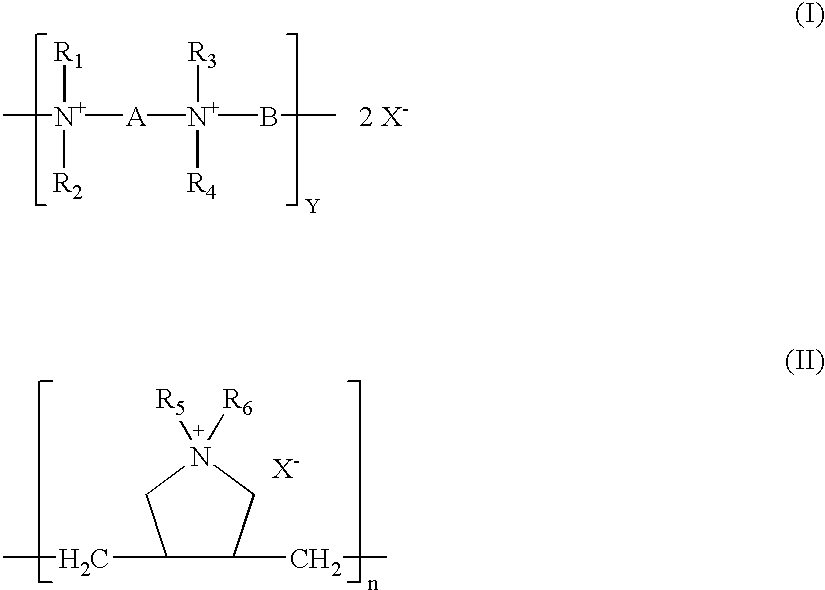Medical devices having antimicrobial coatings thereon
- Summary
- Abstract
- Description
- Claims
- Application Information
AI Technical Summary
Benefits of technology
Problems solved by technology
Method used
Image
Examples
example 1
Preparation of Coating Solutions
Polyacrylic Acid (PAA) Solution
[0099]A solution of polyacrylic acid (PAA) having an averaged molecular weight of about 90,000 is prepared by dissolving a suitable amount of PAA in water to have [PAA]=0.001 M. PAA concentration is calculated based on the repeating unit in PAA. Once dissolved, the pH of the PAA solution is adjusted to a desired value.
Poly(Allylamine Hydrochloride) (PAH) Solution
[0100]A solution of poly(allylamine hydrochloride) (PAH) having an averaged molecular weight of about 60,000 is prepared by dissolving a suitable amount of the material in water to form a 0.001 M PAH solution. PAH concentration is calculated based on the repeating unit in PAH. Once dissolved, the pH of the PAH solution is adjusted to a desired value.
Polyquat (PQ) Solutions
[0101]A solution of polyquat (PQ6-6) of formula (I), in which R1, R2, R3, and R4 are methyl groups, and A and B are hexamethylene groups, is prepared by dissolving a suitable amount of PQ6-6 in ...
example 2
Preparation of Contact lenses Having LbL Coatings
[0105]This example illustrates LbL coatings and several types of antimicrobial coatings which are formed on soft contact lenses made of a fluorosiloxane hydrogel material, lotrafilcon A.
(1) Coating Comprising Four and Half Bilayers:
[0106]PAA / PAH / PAA / PAH / PAA / PAH / PAA / PAH / PAA
[0107]The contact lenses are dipped in a PAA solution (0.001 M, pH 2.5) for 30 min, rinsed with ultra-pure water, then dipped in a PAH solution (0.001 M, pH 7.5) for 5 minutes, rinsed with ultra-pure water for 1 minute. Three more bilayers are added by alternatively dipping in the solutions of PAA (0.001 M, pH 3.5) and PAH (0.002M, pH 7.5), with a rinse step in-between. The contact lenses with four bilayers of polyelectrolytes is dipped in the PAA solution (0.001 M, pH 3.5) and rinsed with ultra-pure water for 1 minute. The lenses are then packaged in saline and sterilized.
(2) Antimicrobial Coating Comprising 6 Bilayers:
[0108]PAA / PAH / PAA / PAH / PAA / PAH / PA / PAH / PAA / PAH / PA...
example 3
[0121]This example illustrates how to produce a covalently-attached antimicrobial coating on a contact lens made of lotrafilcon A, lotrafilcon B, or Balafilcon.
[0122]The contact lens is functionalized by spraying with or dipped into a diaziridine compound and then covalently coupling the diaziridine compound to the contact lens via a thermal process. Such functionalized lens is placed in an open dish containing a polyquat (PQ6-6, PQ6-10, PQ6-12, or PDADMAC) solution of about 10 μg / ml and irradiated with blue light for 30 minutes.
PUM
| Property | Measurement | Unit |
|---|---|---|
| Angle | aaaaa | aaaaa |
| Fraction | aaaaa | aaaaa |
| Fraction | aaaaa | aaaaa |
Abstract
Description
Claims
Application Information
 Login to View More
Login to View More - R&D
- Intellectual Property
- Life Sciences
- Materials
- Tech Scout
- Unparalleled Data Quality
- Higher Quality Content
- 60% Fewer Hallucinations
Browse by: Latest US Patents, China's latest patents, Technical Efficacy Thesaurus, Application Domain, Technology Topic, Popular Technical Reports.
© 2025 PatSnap. All rights reserved.Legal|Privacy policy|Modern Slavery Act Transparency Statement|Sitemap|About US| Contact US: help@patsnap.com



